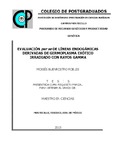| dc.description.abstract | El maíz (Zea mays L.) es un cultivo estratégico y destaca como alimento básico desde el punto de vista económico-social. Sin embargo, la producción de grano para consumo humano, se ve limitada por la dificultad de incrementar el área de cultivo. Una manera de incrementar la productividad de los cultivos es a través del mejoramiento genético, mediante formación de híbridos y sintéticos con alto potencial de rendimiento, calidad y amplia adaptación. Con el objetivo de determinar el rendimiento potencial per se de líneas de maíz exótico irradiado con Co60 y de híbridos simples que se generaron con ellas, se evaluaron 53 líneas progenitoras derivadas de 10 líneas de alto potencial de rendimiento altamente homocigóticas, seis cruzas simples y dos híbridos comerciales como testigos. La evaluación se realizó en 2015 en tres ambientes: Montecillo, Chapingo y Tecámac, Estado de México, bajo un diseño experimental de bloques completos al azar, tres repeticiones con parcelas de dos surcos, 6 m de largo, con 80 cm entre surcos y 40 cm entre plantas. Se midió días a floración masculina (DFM); altura en cm de planta y mazorca (AP, AM); rendimiento de grano por hectárea (t ha-1) (RG); longitud y diámetro en cm de mazorca (LMz, DMz); número de hileras por mazorca (NHM); número de granos por hilera (NGH). Hubo significancia entre ambientes, entre genotipos, y en la interacción genotipo x ambiente para todas las variables. El RG de las 10 mejores líneas superó 3.4 t ha-1, lo que muestra su potencial como progenitores de híbridos de cruza simple. Las cruzas 99 x 107, 107 x 206 y 106 x 180 fueron las más precoces con rendimientos de 8.432 t ha-1, 8.432 t ha-1 y 8.276 t ha-1, respectivamente, y estadísticamente diferentes a los híbridos testigo HS-2 (9.421 t ha-1) y H-40 (8.913 t ha-1). _______________ PER SE EVALUATION OF INBRED LINES DERIVED FROM GAMMA-IRRADIATED EXOTIC GERMPLASM. ABSTRACT: Being a strategic crop for production as food, maize (Zea mays L.) stands as a staple food from the economical-social point of view. However, grain production for human consumption is limited by the difficulty of increasing the growing area. One way to increase crop productivity is through genetic improvement by means synthetic and hybrids formation with high yield potential, quality and wide adaptation. In order to determine the per se potential performance of exotic maize lines radiated with Co60 and simple hybrids that were generated with them, 53 progenitor lines highly homozygous derived from 10 lines of high yield potential, six single crosses and two commercial hybrids as checks were evaluated. The evaluation was carried out in 2015 in three environments: Montecillo, Chapingo and Tecamac, State of Mexico, under an experimental design of complete randomized blocks, three repetitions with plots of two rows, 6 m long, with 80 cm between rows and 40 cm between plants. The variables measured were days to male flowering (DFM); plant and ear height in cm (AP, AM), grain yield per hectare (t ha- 1) (RG); ear length and ear diameter in cm (LMz, DMz); number of rows per ear (NHM); number of grains per row (NGH). There was significance for the following sources of variation: environments, genotypes, and the interaction genotype x environment for all variables. The RG of the top best lines exceeded the threshold 3.4 t ha-1, which shows their potential as parents of single cross hybrids. The crosses 99 x 107, 107 x 206 and 106 x 180 were the more precocious with yields of 8.432 t ha-1, 8.432 t ha-1 and 8.276 t ha-1, respectively, and statistically different to the hybrid checks HS-2 (9.421 t ha-1) and H-40 (8.913 t ha-1). | es_MX |


